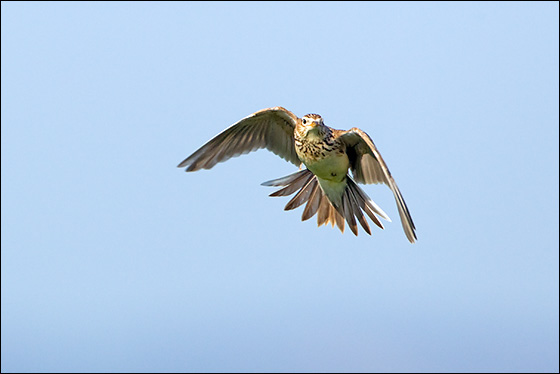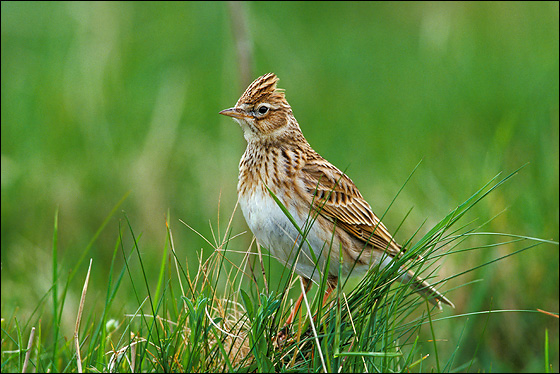Skylark (Alauda arvensis)
The reason for this familiarity is simple. As people have cleared forests and other habitats to make way for fields and farmland, the adaptable Skylark has followed along with them. Over the centuries this bird’s ecstatic song has poured down on to those working the land, so much so that it has become lodged in a common consciousness and sense of place.
The song is sweet enough on the ear, with its high pitch, exuberant tone and effortless delivery. It is varied, too, incorporating motifs from other birds as well as the Skylark’s own repertoire. But its special property is its sustained nature; when a lark is singing there is no break, no real phrasing, just a stream of unbroken sound like the flow of a small brook. It is usually sung in a display-flight. The sound starts just after the bird lifts off at a steep angle to the ground, continues on its rise to 50 m or more, is maintained for a period of hovering (at 10-12 wing-beats per second), and accompanies the display’s slow, spiralling descent. Only for the final plummet to earth does the Skylark’s song fall silent, so that the bird can reach the ground with a degree of privacy.
It is easy to imagine, when you walk along the edge of a field densely populated by these birds, that each song is interminable. But it isn’t true. The average song-flight goes on for just 2½ minutes, and even a more passionate performance rarely goes beyond 5. The reason, then, that one’s ears may ring with lark song at the end of a summer afternoon is that Skylarks often hold contiguous territories, and one male may simply follow another into the sky, without any interval.
It is certainly true that larks rise early. In continental Russia, for example, there is a sustained period of song between 02.30 and 11.00 in June, and in southern Sweden most birds are underway by 03.00 at the same time of year. The males, who are the main performers, are under pressure to keep singing to maintain their territorial boundaries, working hard like city workers afraid of the sack. Singing is surrounded by a macho culture. If a dangerous predator such as a Merlin attacks, the best males carry on singing regardless of the risk, and suffer fewer casualties as a result of their cheek – perhaps the predator recognises their audacity as strength, and seeks out cowering birds instead. So there is little vocal respite, for any reason. Birds holding territory all year will even sing in January on mild days.
The Skylark is a bird of fields and grasslands, being much more tolerant of low growth than other larks. Its diet through the year tends to follow the agricultural cycle: cereal grain and weed seeds in autumn, leaves and seeds in winter, recently sown cereal grain again in spring, and then insects in summer when the crops are growing. All food is obtained on the ground, by visual searching and digging. The latter method is put to use to find newly sown grain, much to the chagrin of farmers.
Skylark breeding is a cut price, rushed affair. Male and female may bring up four broods in a season, and so they usually stick together and shun the time consuming process of changing mates. The nest is a simple lined scrape, the sort of structure that Ikea might sell. The clutch is incubated for only 11 short days (one of the shortest periods among European birds), and the young leave the nest half-ready, sometimes after only 8 days. They are looked after for about 25 days after hatching, and are then sent out, with bargain plumage, into the wild to fend for themselves.


